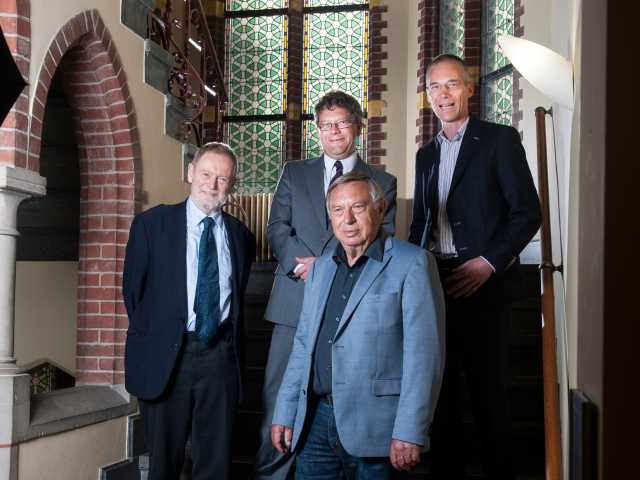25 years of telling the story of the world economy through data
| Date: | 15 January 2018 |

The Groningen Growth and Development Centre (GGDC) was founded in 1992 within the Economics Department of the University of Groningen. It recently marked 25 years since its founding, with a jubilee conference on the themes that have long been key to the centre’s work: long-run growth, productivity and global value chains.
Originally, GGDC was set up by a group of researchers working on comparative analysis of economic performance over time and across countries in the tradition of Angus Maddison. More recently, it has grown into a research centre that studies the interactions of globalisation, technology and institutional change, and its impact on long-run economic growth, structural change, productivity and inequality.
“The GGDC has acquired an international reputation as provider of high-quality research and statistics on economic growth. This has been developed through a strategy of local capacity building, international cooperation, and public sharing of research results,” said current director Marcel Timmer, professor of economic growth and development at the Faculty of Economics and Business.
“The importance of teamwork cannot be overestimated. Our impact as a group is so much more than that any individual could achieve.”
The GGDC provides unique information on comparative trends in the world economy in the form of easily accessible datasets, along with comprehensive documentation. These data are made publicly available, which enables researchers and policy makers from all over the world to analyse productivity, structural change, and economic growth in detail. This includes the Penn World Tables, the World Input-Output Database (WIOD) and the Maddison Historical Statistics.
An important aim of the GGDC is to carry out, and encourage, new empirical research that is innovative and at the same time policy relevant. This is done through the GGDC’s own research, by compiling comprehensive databases for public use and submitting (joint) proposals to finance collaborative research in this field. International cooperation is key given the comparative nature of the research. The centre also organises seminars, summer schools and conferences, such as the annual Maddison lecture series.
The GGDC consists of a dedicated group of senior and junior staff members, PhD students and support staff, with a large collaborating network of local, national and international affiliates.
Here is a timeline of 25 years of work of successful international collaborative research.
- 1992 The Groningen Growth and Development Centre is founded by Angus Maddison, Rainer Fremdling, Eddy Szirmai and Bart van Ark.
- 1992 International Comparisons of Output and Productivity (ICOP) project launched. Results used by academics and international organisations such as McKinsey, OECD and ILO.
- 1993 International conference with proceedings published as “Explaining economic growth: Essays in honour of Angus Maddison”: Adam Szirmai, Bart van Ark and Dirk Pilat (eds.).
- 2001 Publication of “The World Economy: A Millennial Perspective” by Angus Maddison, new estimates of economic growth in the world economic between AD 1 and 2010.
- 2003 The 4-year EU KLEMS Project begins. Productivity in the European Union: A Comparative Industry Approach creates a comparative economic database for European Union member states, allowing policies to increase growth and competitiveness to be evaluated. It is funded by the European Commission with a consortium of 18 research institutes around the world.
- 2005 The Historical National Accounts project and data hub begins. It allows for Gross Domestic Product across different industries to be compared internationally for the 19th and 20th centuries. The database is a complement to Maddison’s estimates of World GDP.
- 2007 The GGDC 10-Sector Database is released. It provides a long-run internationally comparable dataset on sectoral productivity performance in Asia, Europe, Latin America and the US.
- 2009 Start of 3 year project the World Input-Output Database (WIOD), funded by the EU, with an international consortium of 12 institutes. It aims to develop new databases, accounting frameworks and models to increase our understanding of the impact of increased interrelatedness of countries and industries.
- 2010 The NWO-funded Modern Times project begins. It analyses sectoral composition and growth in European economies to explain why Europe fell behind the United States in the first half of the 20th century.
- 2010 The Maddison Project begins. Initiated by a group of close colleagues of Angus Maddison, the project aims to continue Maddison's work on measuring economic performance in the world economy.
- 2011 Start of Angus Maddison lecture series, bringing leading scholars from around the world to Groningen to present on major topics of economic history, growth and development.
- 2012 Official launch of WIOD database in Brussels, during a high-level conference on "Competitiveness, trade, environment and jobs in Europe: Insights from the new World Input Output Database (WIOD)", attended by EU Trade Commissioner Karel de Gucht.
- 2013 Release of the next generation of the Penn World Table, PWT 8.0 by GGDC in collaboration with Robert Feenstra and Alan Heston, funded by US NSF. The most consulted macro database in economics, and underlying research is published in the American Economic Review.
- 2013 Project on African growth with Dani Rodrik and Maggie McMillan funded by UK DFID. The Africa Sector Database (ASD) is released, providing a long-run internationally comparable dataset for eleven Sub-Saharan African countries from 1960 onwards.
- 2013 NWO VICI grant awarded to Herman de Jong: “Pessimism and prosperity. The welfare paradox of interwar Europe in a global perspective”.
- 2015 NWO VICI grant awarded to Marcel Timmer: “Modelling Global Value Chains: a new framework to study trade, jobs and income inequality in an interdependent world”.
- 2016 Latest version of Penn World Table, PWT 9.0, released, reaching more than 1,000 citations on Google scholar.
- 2016 The GGDC website logs more than 300,000 website in one year.
- 2016 Wallenberg Academy Fellowship goes to Jutta Bolt.
- 2017 International silver jubilee conference of the GGDC is held in Groningen.

